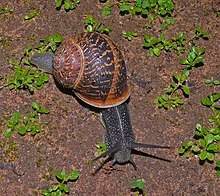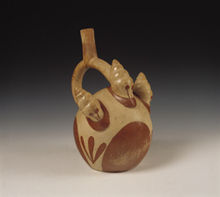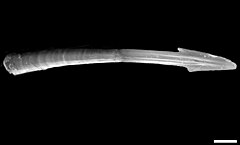Is A Snail A Bug Or An Animal
| Snails | |
|---|---|
 | |
| Helix pomatia, a species of land snail | |
| Scientific nomenclature | |
| Kingdom: | Animalia |
| Phylum: | Mollusca |
| Course: | Gastropoda |

A snail is, in loose terms, a shelled gastropod. The name is most oft practical to state snails, terrestrial pulmonate gastropod molluscs. However, the mutual name snail is also used for most of the members of the molluscan class Gastropoda that take a coiled shell that is large plenty for the animal to retract completely into. When the word "snail" is used in this near full general sense, it includes not just land snails but also numerous species of body of water snails and freshwater snails. Gastropods that naturally lack a crush, or have just an internal beat out, are mostly chosen slugs, and land snails that have merely a very small-scale shell (that they cannot retract into) are often chosen semi-slugs.
Snails have considerable human relevance, including as food items, as pests, and as vectors of illness, and their shells are used as decorative objects and are incorporated into jewelry.[1] The snail has also had some cultural significance, tending to be associated with languor. The snail has also been used as a figure of speech in reference to slow-moving things. The snail is the aforementioned or like shape as the cochlea.[2]
Overview
Snails that respire using a lung belong to the group Pulmonata. As traditionally divers, the Pulmonata were found to exist polyphyletic in a molecular study per Jörger et al., dating from 2010.[3] Simply snails with gills also form a polyphyletic group; in other words, snails with lungs and snails with gills grade a number of taxonomic groups that are non necessarily more closely related to each other than they are related to some other groups.
Both snails that accept lungs and snails that have gills have diversified so widely over geological time that a few species with gills can be found on land and numerous species with lungs can be found in freshwater. Fifty-fifty a few marine species have lungs.
Snails can be plant in a very wide range of environments, including ditches, deserts, and the abyssal depths of the sea. Although land snails may exist more familiar to laymen, marine snails constitute the majority of snail species, and have much greater diversity and a greater biomass. Numerous kinds of snail can also be found in fresh water.
About snails have thousands of microscopic tooth-like structures located on a banded ribbon-like tongue called a radula. The radula works similar a file, ripping food into small pieces. Many snails are herbivorous, eating plants or rasping algae from surfaces with their radulae, though a few land species and many marine species are omnivores or predatory carnivores. Snails cannot absorb colored pigments when eating paper or cardboard so their feces are also colored.[4]
Several species of the genus Achatina and related genera are known equally giant African land snails; some grow to 15 in (38 cm) from snout to tail, and counterbalance 1 kg (2 lb).[5] The largest living species of body of water snail is Syrinx aruanus; its crush tin can measure upwards to ninety cm (35 in) in length, and the whole animal with the shell can weigh up to 18 kg (xl lb). Recently, the smallest land snails, Angustopila dominikae, have been discovered in China, and measure out 0.86mm long.[6]
The snail Lymnaea makes decisions past using only two types of neurons: ane deciding whether the snail is hungry, and the other deciding whether at that place is food in the vicinity.[7]
The largest known country gastropod is the African giant snail Achatina achatina, the largest recorded specimen of which measured 39.three centimetres (15.5 in) from snout to tail when fully extended, with a shell length of 27.3 cm (10.7 in) in December 1978. Information technology weighed exactly 900 g (ii lb). Named Gee Geronimo, this snail was endemic past Christopher Hudson (1955–79) of Hove, East Sussex, U.k., and was collected in Sierra Leone in June 1976.[8]
Diet

Snails that alive in nature but are fed by humans. (Kadıköy, Istanbul - Turkey)
Snails eating habits vary widely, with some being generalists and some being specialist feeders. [9] Snails feed at night.[ten] They feed primarily on decaying organic matter.[10] Their diet also includes fungi, lichens, green foliage, worms, centipedes, insects, animate being feces, carrion, and other slugs.[ten] Some snails feed on other snails too.[10]
Types of snails past habitat
Slugs

Gastropods that lack a conspicuous shell are commonly called slugs rather than snails.[eleven] Some species of slug have a maroon-dark-brown shell, some have only an internal vestige that serves mainly as a calcium lactate repository, and others take some to no beat at all. Other than that in that location is little morphological deviation betwixt slugs and snails. There are however important differences in habitats and behavior.
A shell-less animate being is much more maneuverable and compressible, so even quite large land slugs can accept advantage of habitats or retreats with very fiddling infinite, retreats that would be inaccessible to a similar-sized snail. Slugs squeeze themselves into bars spaces such equally nether loose bark on trees or under stone slabs, logs or wooden boards lying on the ground. In such retreats they are in less danger from either predators or desiccation. Those are ofttimes suitable places for laying their eggs.
Slugs as a group are far from monophyletic; scientifically speaking "slug" is a term of convenience with little taxonomic significance. The reduction or loss of the shell has evolved many times independently within several very different lineages of gastropods. The various taxa of land and ocean gastropods with slug morphology occur inside numerous college taxonomic groups of shelled species; such independent slug taxa are not in general closely related to one another.
Human being relevance

Cornu aspersum – garden snail
State snails are known as an agronomical and garden pest but some species are an edible delicacy and occasionally household pets. In addition, their mucus can also be used for pare care products.
In agronomics
In that location are a diverseness of snail-control measures that gardeners and farmers utilize in an try to reduce damage to valuable plants. Traditional pesticides are still used, as are many less toxic control options such equally full-bodied garlic or wormwood solutions. Copper metal is besides a snail repellent, and thus a copper band around the body of a tree will prevent snails from climbing up and reaching the foliage and fruit. A layer of a dry out, finely ground, and scratchy substance such every bit diatomaceous earth tin likewise deter snails.[12]
The decollate snail (Rumina decollata) will capture and eat garden snails, and because of this it has sometimes been introduced as a biological pest control agent. However, this is non without bug, as the decollate snail is only as probable to assault and devour other gastropods that may represent a valuable part of the native animal of the region.
As nutrient

In French cuisine, edible snails are served for example in Escargot à la Bourguignonne. The practice of rearing snails for food is known as heliciculture. For purposes of cultivation, the snails are kept in a dark place in a wired cage with dry straw or dry out wood. Coppiced vino-grape vines are oft used for this purpose. During the rainy period, the snails come up out of hibernation and release nearly of their mucus onto the dry wood/straw. The snails are then prepared for cooking. Their texture when cooked is slightly chewy and tender.
Also equally being relished as gourmet food, several species of land snails provide an easily harvested source of protein to many people in poor communities effectually the world. Many land snails are valuable considering they can feed on a wide range of agricultural wastes, such as shed leaves in assistant plantations. In some countries, giant African land snails are produced commercially for food.
Land snails, freshwater snails and sea snails are all eaten in many countries. In certain parts of the globe, snails are fried as for example, in Republic of indonesia, they are fried as satay, a dish known as sate kakul. The eggs of certain snail species are eaten in a way similar to the fashion caviar is eaten.[ citation needed ]
In Bulgaria, snails are traditionally cooked in an oven with rice or fried in a pan with vegetable oil and red paprika pulverisation. Before they are used for those dishes, however, they are thoroughly boiled in hot h2o (for up to xc minutes) and manually extracted from their shells. The two species almost commonly used for food in the country are Helix lucorum and Helix pomatia.[ citation needed ]
Famine food
Snails and slug species that are not normally eaten in certain areas take occasionally been used every bit dearth food in historical times. A history of Scotland written in the 1800s recounts a clarification of various snails and their use as food items in times of plague.[13]
Parasitic diseases
Snails can as well be associated with parasitic diseases such as schistosomiasis, angiostrongyliasis, fasciolopsiasis, opisthorchiasis, fascioliasis, paragonimiasis and clonorchiasis, which can exist transmitted to humans.
Cultural depictions

Symbolism
Because of its slowness, the snail has traditionally been seen as a symbol of laziness. In Christian culture, it has been used every bit a symbol of the deadly sin of sloth.[14] [15] Psalms 58:8 uses snail slime equally a metaphorical punishment. In Mayan mythology, the snail is associated with sexual want, beingness personified past the god Uayeb.[16]
Divination and other religious uses
Snails were widely noted and used in divination.[14] The Greek poet Hesiod wrote that snails signified the time to harvest past climbing the stalks, while the Aztec moon god Tecciztecatl diameter a snail shell on his dorsum. This symbolised rebirth; the snail's penchant for appearing and disappearing was analogised with the moon.[17]
Love darts and Cupid

Professor Ronald Chase of McGill University in Montreal has suggested the ancient myth of Cupid'due south arrows might be based on early observations of the love dart behavior of the land snail species Cornu aspersum.[18]
Metaphor
In gimmicky speech, the expression "a snail'due south footstep" is often used to describe a boring, inefficient process. The phrase "snail post" is used to mean regular postal service delivery of newspaper letters as opposed to the delivery of email, which can be virtually instantaneous.
In medieval and Renaissance manuscripts snails are depicted as a comic relief due to the similarity between the armour of knights and the trounce of snails.[19]
In Indonesian mythology

Dewi Sekartaji equally Keong Emas
Keong Emas (Javanese and Indonesian for Golden Snail) is a pop Javanese sociology about a princess magically transformed and contained in a golden snail shell. The folklore is a part of popular Javanese Panji bicycle telling the stories about the prince Panji Asmoro Bangun (too known every bit Raden Inu Kertapati) and his consort, princess Dewi Sekartaji (also known every bit Dewi Chandra Kirana).
Textiles
Certain varieties of snails, notably the family Muricidae, produce a secretion that is a colour-fast natural dye. The ancient Tyrian purple was made in this way equally were other imperial and blue dyes.[20] [21] [22] The extreme expense of extracting this secretion is sufficient quantities express its apply to the very wealthy. It is such dyes every bit these that led to sure shades of purple and blue being associated with royalty and wealth.[23]
As pets
Throughout history, snails have been kept every bit pets. At that place are many famous snails such as Lefty (Born Jeremy) and within fiction, Gary and Brian the snail.[24]
See likewise
- Gastropod shell
- Pasilalinic-sympathetic compass
- Jeremy (snail)
- Land snail
- Freshwater snail
- Sea snail
References
- ^ "Snails used in Jewellery".
- ^ Monroe, Don (3 March 2006). "Why the inner ear is snail shaped". Physical Review Focus. Vol. 17. p. 8.
- ^ Jörger, Katharina G; Stöger, Isabella; Kano, Yasunori; Fukuda, Hiroshi; Knebelsberger, Thomas; Schrödl, Michael (2010). "On the origin of Acochlidia and other enigmatic euthyneuran gastropods, with implications for the systematics of Heterobranchia". BMC Evolutionary Biology. 10 (1): 323. doi:10.1186/1471-2148-x-323. PMC3087543. PMID 20973994.
- ^ "Floor tiles made of coloured snail poo by Lieske Schreuder - design". 26 November 2013. Retrieved 29 March 2018.
- ^ Fredericks, Anthony D. (2010). How Long Things Alive & How They Alive As Long Equally They Practice . Stackpole Books. p. 73. ISBN9780811736220 . Retrieved xix June 2012.
- ^ Hogenboom, Melissa (27 July 2020). "The earth's smallest snail has been discovered". BBC.
- ^ Crossley, Michael; Staras, Kevin; Kemenes, György (3 June 2016). "A two-neuron system for adaptive goal-directed decision-making in Lymnaea". Nature Communications. 7: 11793. Bibcode:2016NatCo...711793C. doi:x.1038/ncomms11793. PMC4895806. PMID 27257106.
- ^ "Largest Snail". Guinness World Records . Retrieved 17 Dec 2016.
- ^ Vendetti, Jann. "A Microscopic Look at Snail Jaws". nhm.org. Natural History Museum Los Angeles County. Retrieved 2022-01-05 .
- ^ a b c d Texas Bug Volume: The Good, the Bad, and the Ugly - Page 144. University of Texas Press. September 2005. ISBN9780292709379.
- ^ "Slug vs Snail - Divergence and Comparison - Diffen". Retrieved 29 March 2018.
- ^ Sanders, April. "Do Egg Shells Assistance Finish Snails From Eating Plants?" Domicile Guides | SF Gate. Accessed 01 July 2019.
- ^ Chambers, Robert (1858). Domestic annals of Scotland, from the reformation to the revolution. W. & R. Chambers. (Too quoted here.
- ^ a b de Vries, Ad (1976). Dictionary of Symbols and Imagery. Amsterdam: Northward-Holland Publishing Company. p. 430. ISBN978-0-7204-8021-four.
- ^ Tresidder, Jack (2006). Symbols and Their Meanings. New York: Barnes & Noble. p. 41. ISBN978-0-7607-8164-vii.
- ^ Susan Milbrath, Star Gods of the Maya: Astronomy in Art, Sociology, and Calendars, University of Texas Press, 01/01/2010
- ^ Cooper, J. C. (1992). Symbolic and Mythological Animals. London: Aquarian Press. p. 213. ISBN978-1-85538-118-vi.
- ^ Mayell, Hillary (Feb thirteen, 2004). "Lovebirds and Love Darts: The Wild World of Mating". news.national-geographic.com. National Geographic Order. Retrieved 2010-02-21 .
- ^ Monge-Nájera, J. (2019). Pulmonate snails equally marginalia in medieval and Renaissance manuscripts: a review of hypotheses. Darwin In Memoriam: History of Science. Web log RPT.https://revistas.ucr.ac.cr/alphabetize.php/rbt/commodity/view/38872
- ^ Ziderman, I. I. (1986). "Purple dye made from shellfish in artifact". Review of Progress in Coloration. 16: 46–52. doi:10.1111/j.1478-4408.1986.tb03743.ten. ISSN 1472-3581.
- ^ Biggam, Carole P. (March 2006). "Whelks and purple dye in Anglo-Saxon England" (PDF). The Archeo+Malacology Grouping Newsletter (9).
- ^ Moorey, Peter (1999). Ancient Mesopotamian Materials and Industries: The Archaeological Evidence . Winona Lake, Indiana: Eisenbrauns. p. 138. ISBN978-1-57506-042-2.
- ^ Nuttall, Zelia (1909). "A Curious Survival in United mexican states of the Use of the Purpura Trounce-fish for Dyeing". In Boas, Franz (ed.). Putnam Anniversary Book. Vol. Anthropological Essays Presented to Fredrick Ward Putnam in Honor of his Seventieth Altogether, by his Friends and Associates. New York: G. E. Stechert & Co. pp. 368–384. LCCN 10011191.
- ^ "BBC Radio 3 - Deadening Radio - Seven of the world'south nearly famous snails". BBC . Retrieved 2020-02-14 .
Gallery
-
Snails feeding on the sea flooring (fifty sec)
-
Video of snail after rain (31 sec)
-
Snail moving on a moisture ground
-
Snail moving across leaves.
External links
| | Wikimedia Commons has media related to Snails. |
- Introduction to Snails, Infoqis Publishing, Co.
Source: https://en.wikipedia.org/wiki/Snail
Posted by: wasonlikeeped.blogspot.com


0 Response to "Is A Snail A Bug Or An Animal"
Post a Comment